Haunted Hue: A Guide to the City's Ancient Tombs
As dusk creeps over Central Vietnam, a jaunty melody echoes across the Perfume River from a fleet of brightly lit dragon boats. Guitars and flutes accompany a chorus of female singers dressed in regal robes. The performers are well versed in "nha nhac" or literally "elegant music," an ancient musical style dating back to the 13th century. Certain songs would be sung at religious ceremonies or royal banquets, supposedly to attract ancient deities and lost spirits. These magical ballads may also be heard by the noble ghosts that may haunt the city's many tombs.
Vietnam's royal history is well-preserved in Hue, the capital during the Nguyen dynasty, the power before French colonization. The legacy of these rulers, specifically their impressive tombs, reveals how the Nguyen dynasty oversaw a transformative era in Vietnamese history. They ruled at a time long after Chinese dominion, allowing the Vietnamese identity to become even more distinct. However, the royals eventually cozied up to French colonists. This is demonstrated by the Europeanization of later tombs, such as the Mausoleum of Emperor Khai Dinh.
Hue's many tombs and relics make for an interesting day of "tomb-hopping." Despite being homes for dead royals, these tombs, now popular tourist attractions, come alive with fascinating history, culture, and mystique.
Ho Quyen - Vietnam's Beastly Colosseum
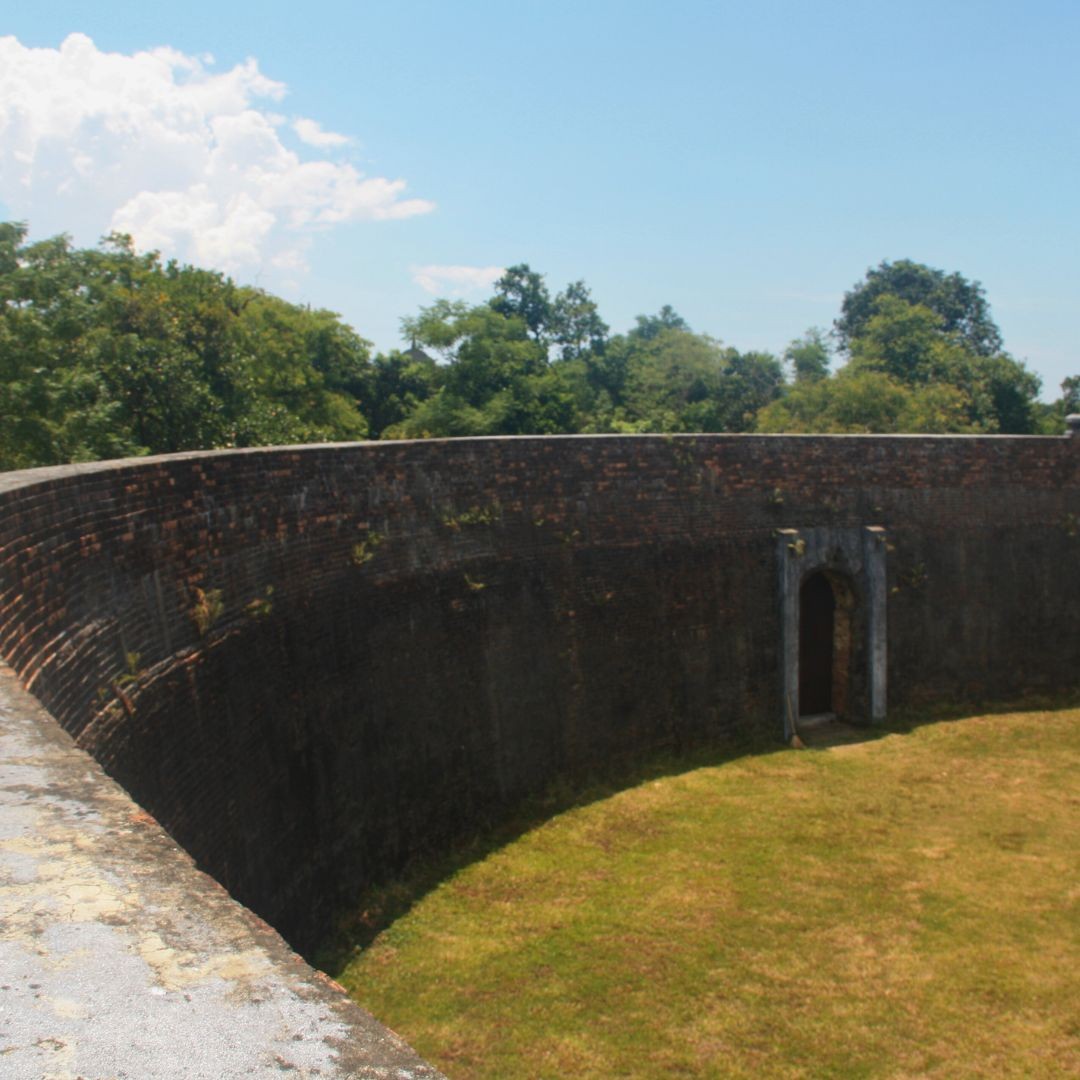 |
| Where elephants once walked. Photo by Glen MacDonald. |
While the Roman Colosseum is far bigger, Ho Quyen's history is no less bloody. Instead of gladiators, Hue's royal court would gather at this spot to watch tigers fight elephants.
Prior to the arena being built, the court would watch the madness unfold from a nearby island on the Perfume River. However, there were several incidents of people being hurt or even killed by the tigers or elephants. After a tiger made an attempt on Emperor Minh Mang's life, the court decided to host the event in a safer location.
The event was held every year and viewed as equally as entertainment, ritual, and training for the elephants. The claws and fangs of the tigers would be removed, guaranteeing an elephant victory.
The last occurrence of this happening was in 1904. Hue historian Phan Thuan An collected testimonials and was able to piece together the results of the wild clash of animals;
"When the female elephant entered the arena, she seemed to be proud, walking back and forth in front of the tiger without fear. King Thanh Thai boasted the creature, saying, "This child is very brave". But suddenly, the tiger jumped on the elephant's forehead the strength of thousands of pounds to push and squeeze it. When the elephant raised her head, the tiger fell to the ground and the elephant used her foot to stomp the tiger to death..."
Somewhere on the premises are the graves of the warrior elephants, who died in service of the Nguyen Lords, making this one of Hue's unofficial tombs.
Nowadays, the epic arena is surrounded by a sleepy Hue suburb. Local aunties sip iced tea and watch over the structure from the shade. The ferocious battles have been replaced with tea time. Gazing over the sunbaked stones, one may hear the sad, ghostly trumpet of slaughtered elephants but instead, it is only a horn from a passing motorist.
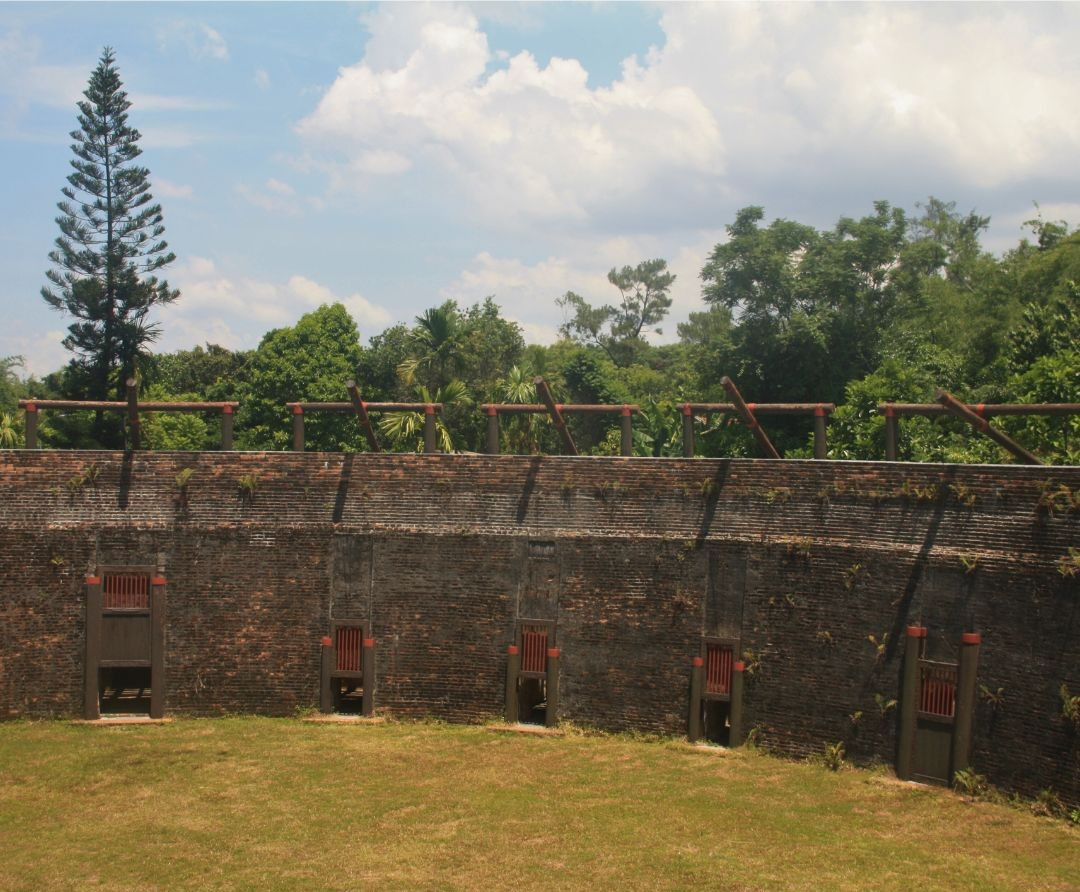 |
| Tiger gates. Photo by Glen MacDonald. |
Tomb of Thieu Tri - Serenity amongst Ruins
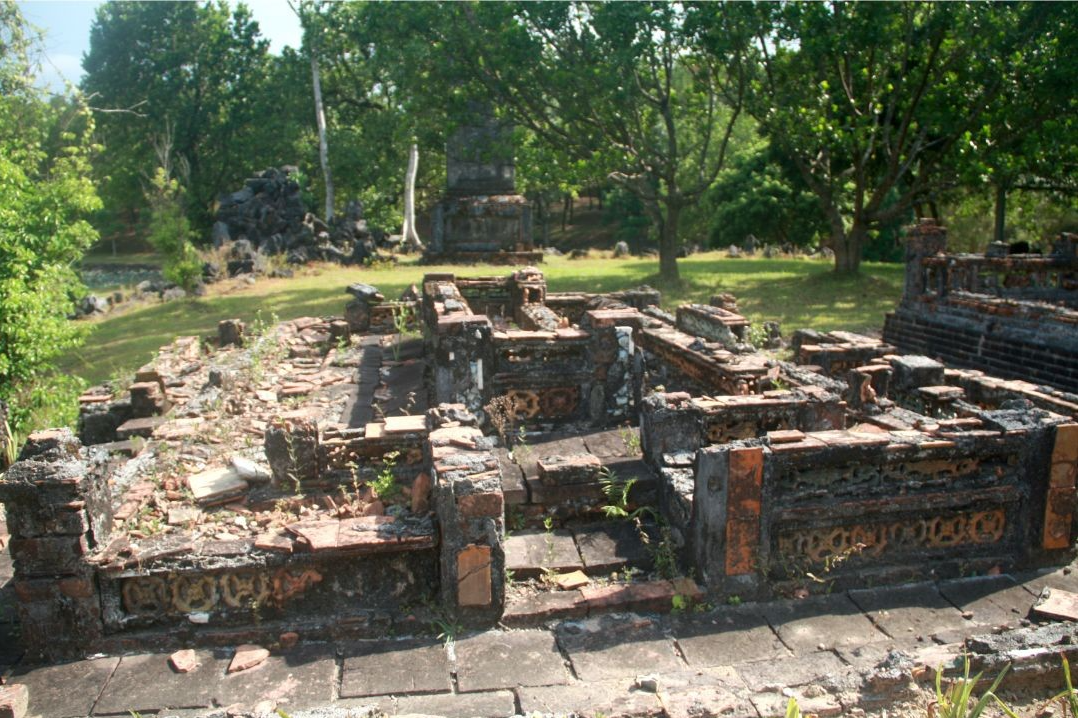 |
| Royal ruins. Photo by Glen MacDonald. |
Western missionaries have entered Vietnam since the 16th century with hopes of spreading Roman Catholicism and cultural influence while casting out the local religions. The earliest missions, led by Portuguese and Spanish priests, did not bring impressive results. Towards to end of the 18th century, as the number of Catholic followers in Vietnam increased, French priests gradually replaced the Portuguese and Spanish.
Similar to his predecessors, Thieu Tri, the third Nguyen king, was cautious with the French missionaries. He planned to make an example of these colonizers by condemning them to death. While many of his mandarins did not follow these orders, Thieu Tri's fierce disapproval of colonial powers has been noted by historians.
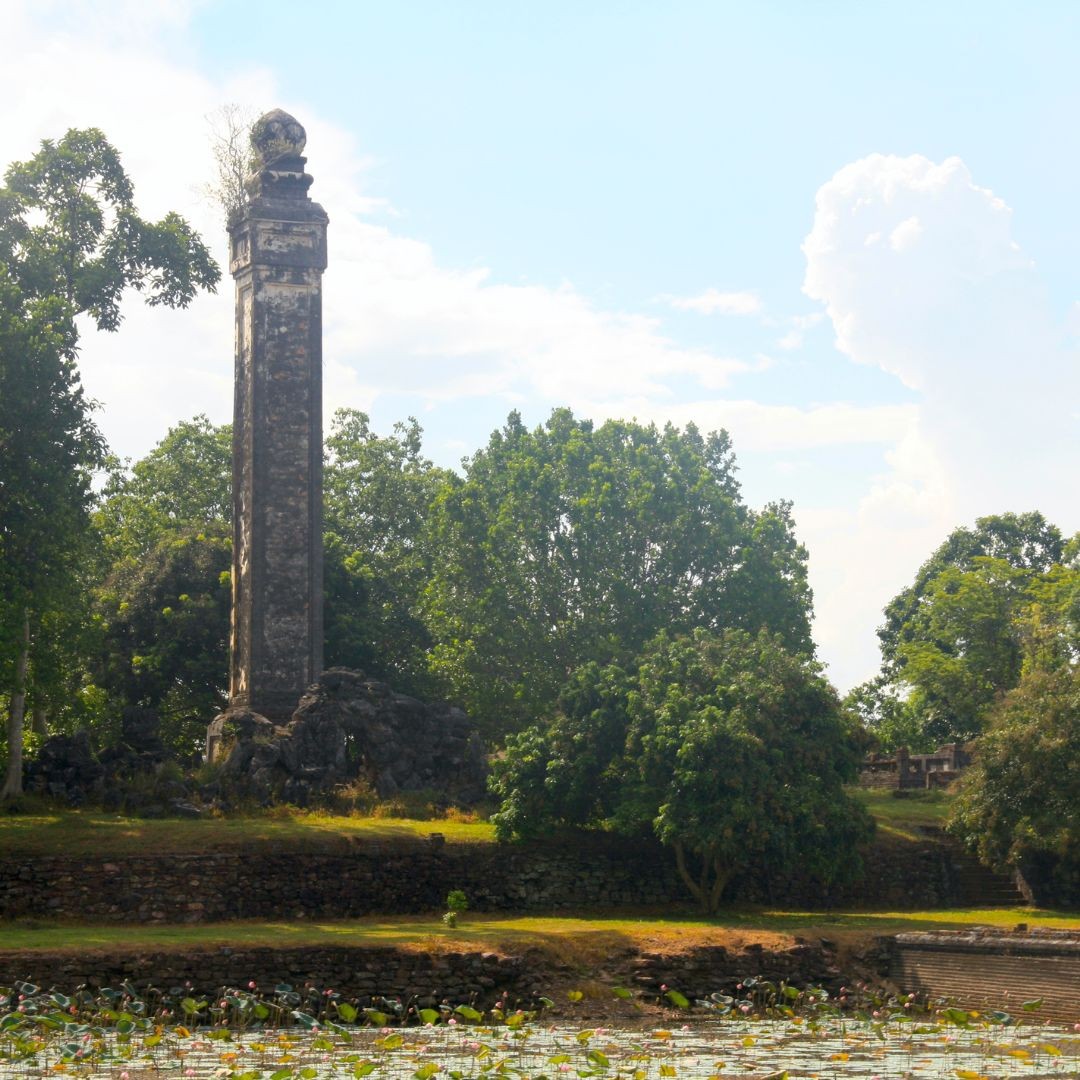 |
| Thieu Tri's pillar. Photo by Glen MacDonald. |
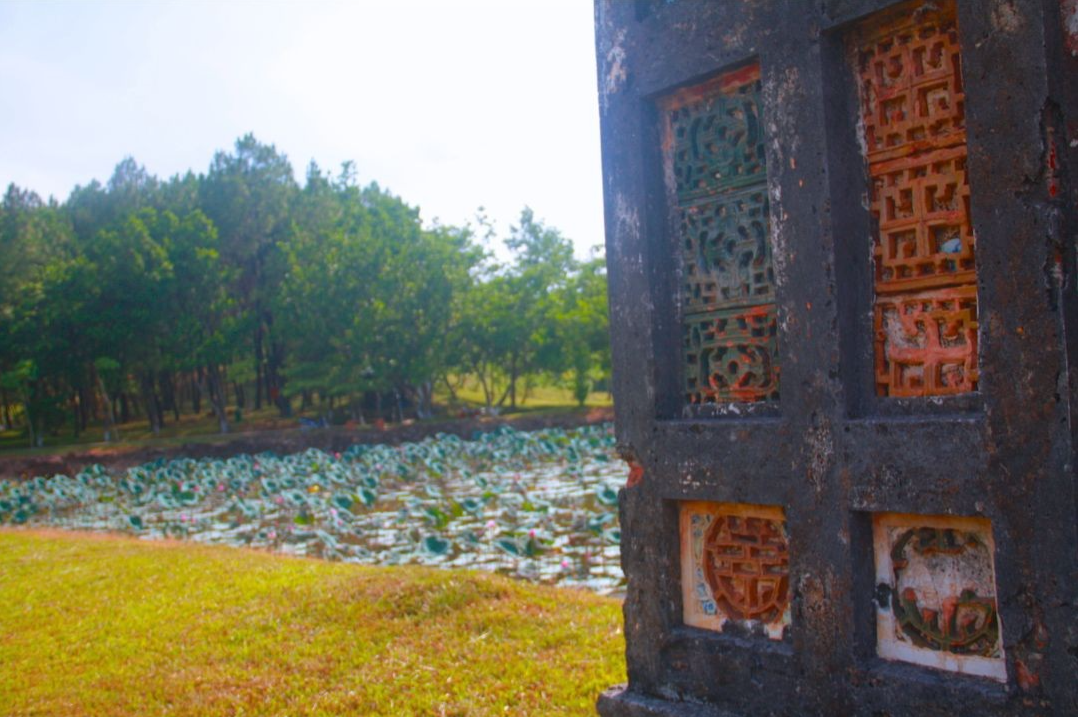 |
| A lotus-filled oasis by Thieu Tri's tomb. Photo by Glen MacDonald. |
Thieu Tri's tomb was named "Xuong Lang" - the tomb of serenity and peace, as it was originally surrounded by green gardens and overlooked vast paddy fields. Nowadays, the Tomb of Thieu Tri is little more than a ruin. Next to the ancient tomb is a lush lotus garden, teeming with dragonflies and butterflies. As the location is out of the way for most tourists, the ghosts of Thieu Tri and his court are often left unbothered.
Mausoleum of Emperor Tu Duc - The Last Free King of Vietnam
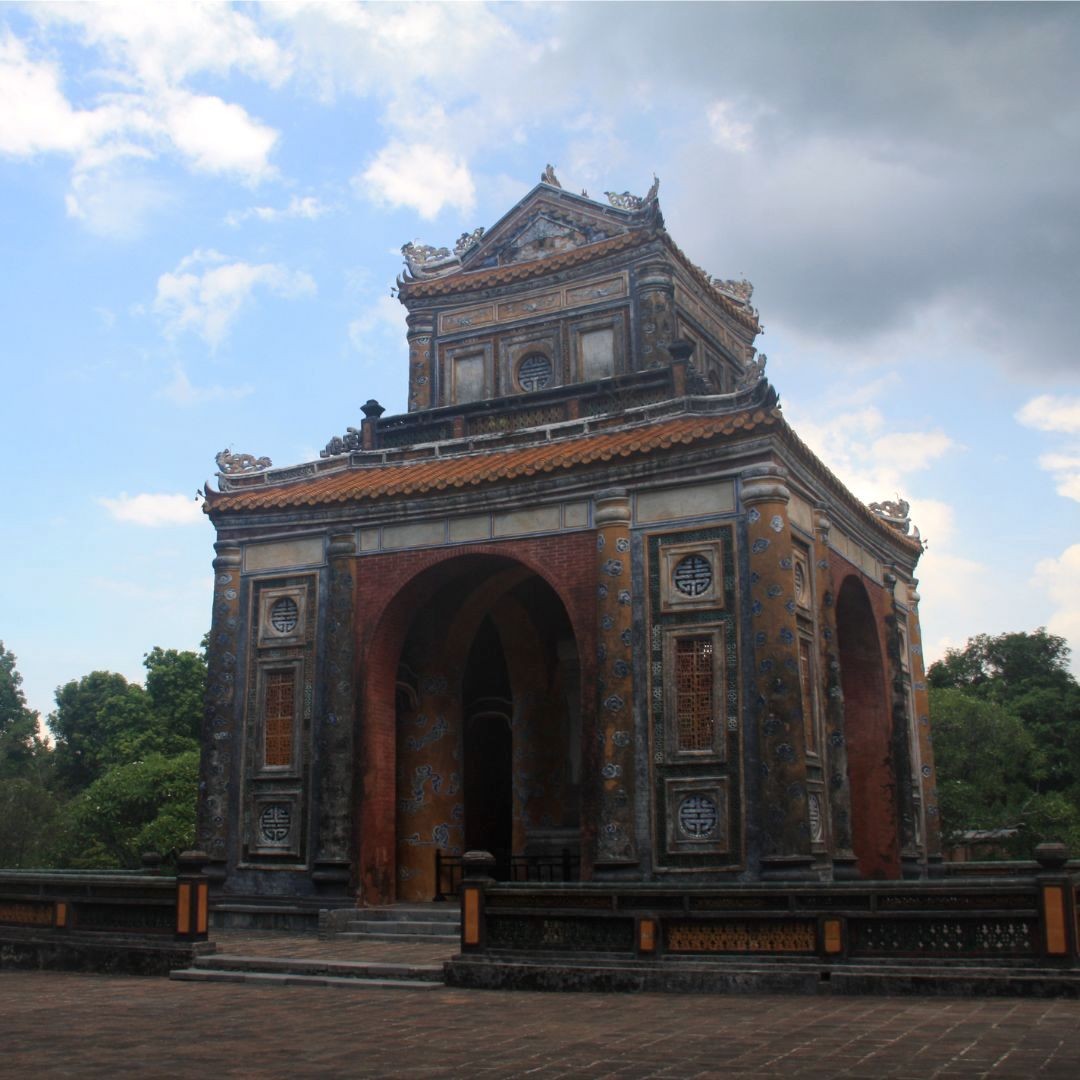 |
| The eternal home of Tu Duc. Photo by Glen MacDonald. |
Although he had the longest reign in the Nguyen Dynasty, Emperor Tu Duc's life was marred in tragedy. It was during his rule that he ceded land to the attacking French colonists and forfeited Hanoi, opening it up for international trade. This marked the beginning of French colonialism in Vietnam, causing the Nguyen Dynasty's power to wan. To make matters worse, Tu Duc was unable to sire a male heir, causing panic and confusion about the future of the royal line.
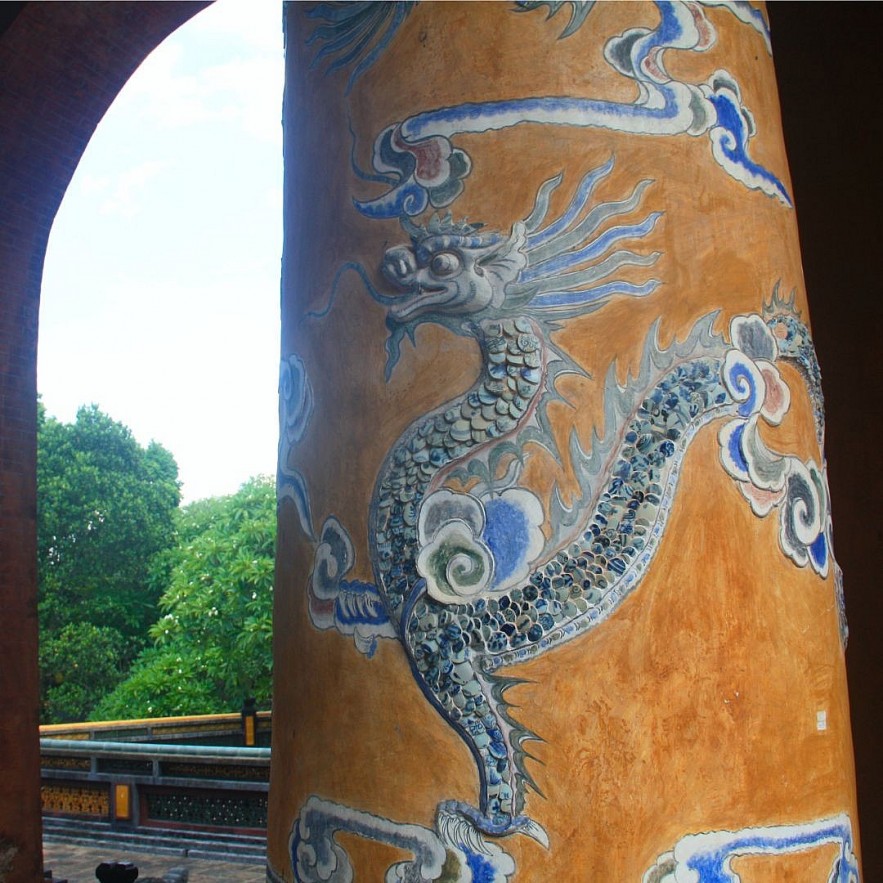 |
| Dragons guard the emperor's tomb. Photo by Glen MacDonald. |
Wanting to escape the troubles of his kingdom and court, Tu Duc focused on making his own oasis within Hue. In the middle of breezy woods, he had built a regal boathouse near a pleasant lake. On most days, Tu Duc would sail from the boathouse to a small island where he would leisurely hunt for small game. Tu Duc's royal paradise would eventually become the grounds for his grand tomb.
Watching over the lake, one can imagine the emperor, paddling towards his beloved island and away from pressing matters of the court. Perhaps, the ghost of Tu Duc still strolls through the well-kept forests and sits beside the lake, impressed with the many tourists snapping photos of his Instagrammable realm.
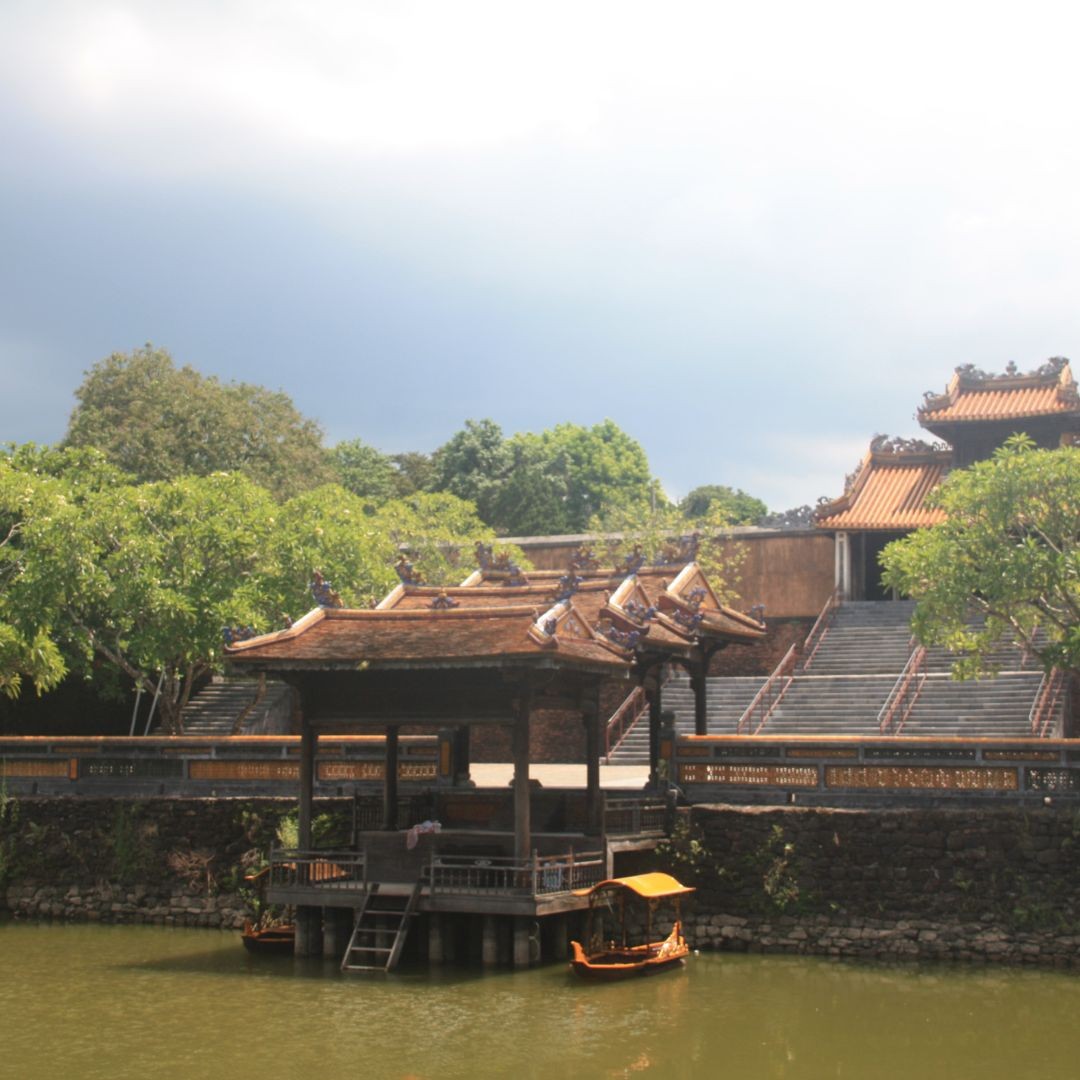 |
| Tranquility amongst the tombs. Photo by Glen MacDonald. |
Despite all of his faults, Tu Duc may be the most self-reflective Nguyen King. With no son to carry on his name, Tu Duc had to write his own stone stele, reviewing his deeds during the reign. Instead of embellishing his accomplishments, Tu Duc solemnly wrote about his regrets, including allowing the French into Vietnam. As it is the largest stele in Vietnam, the stone is a heavy reminder of an old king's remorse.
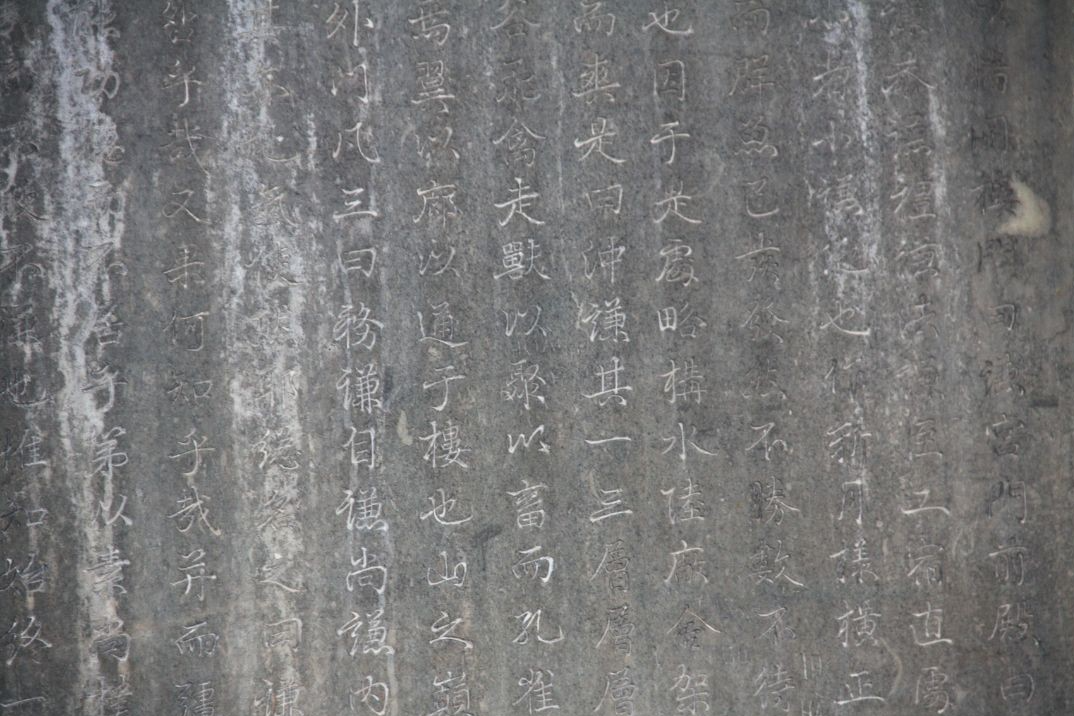 |
| Tu Duc's stele. Photo by Glen MacDonald. |
Although he is buried in a grand atmosphere, many believe Tu Duc is not in the tomb. According to local legends, loyal servants took Tu Duc's body and buried it in a secret place, protecting their king from grave robbers. The servants were then executed by the royal court to keep the location safe forever.
In lieu of male heirs, Tu Duc adopted three of his nephews, Duc Duc, Kien Phuc, and Dong Khanh. Following Tu Duc's death, Duc Duc was enthroned but just as quickly dethroned three days later, due to the royal court finding him to be far too decadent for a country verged of French occupation. Later on, Kien Phuc was eventually named heir but only ruled for a few months before his mysterious death. Bittersweetly, Kien Phuc's tomb lies a few meters away from his adoptive father.
Tomb of Emperor Dong Khanh - A Site of Eurasian Beauty
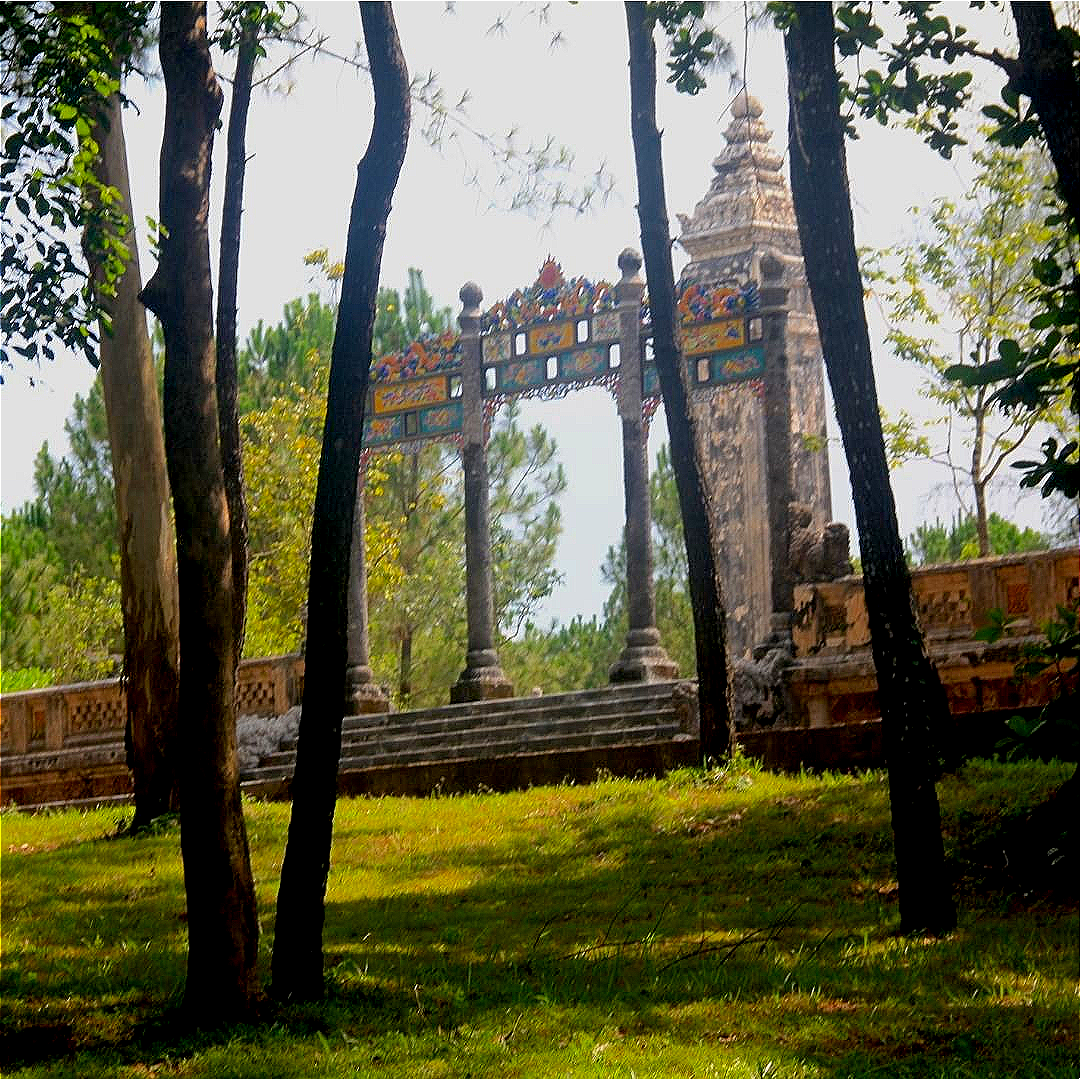 |
| The gateway to the emperor's tomb. Photo by Glen MacDonald. |
Once French colonists entered Vietnam, there was no stopping their onslaught. The European influence began to merge with the existing Vietnamese culture. This combination is extremely apparent in the tomb of Emperor Dong Khanh, a young emperor who only ruled over Vietnam for four years.
Before succumbing to a fatal disease, Dong Khanh immersed himself in French culture. The young king would drink Bordeaux wine and canned milk, gifts from the French nation. He also liked to use French-made toys. As an ally to the French, Dong Khanh was used by the colonizers as a diplomat with the aim of disengaging Vietnamese revolutionaries. Although he ultimately failed to squash the Vietnamese rebellion, Dong Khanh was still favored by the French.
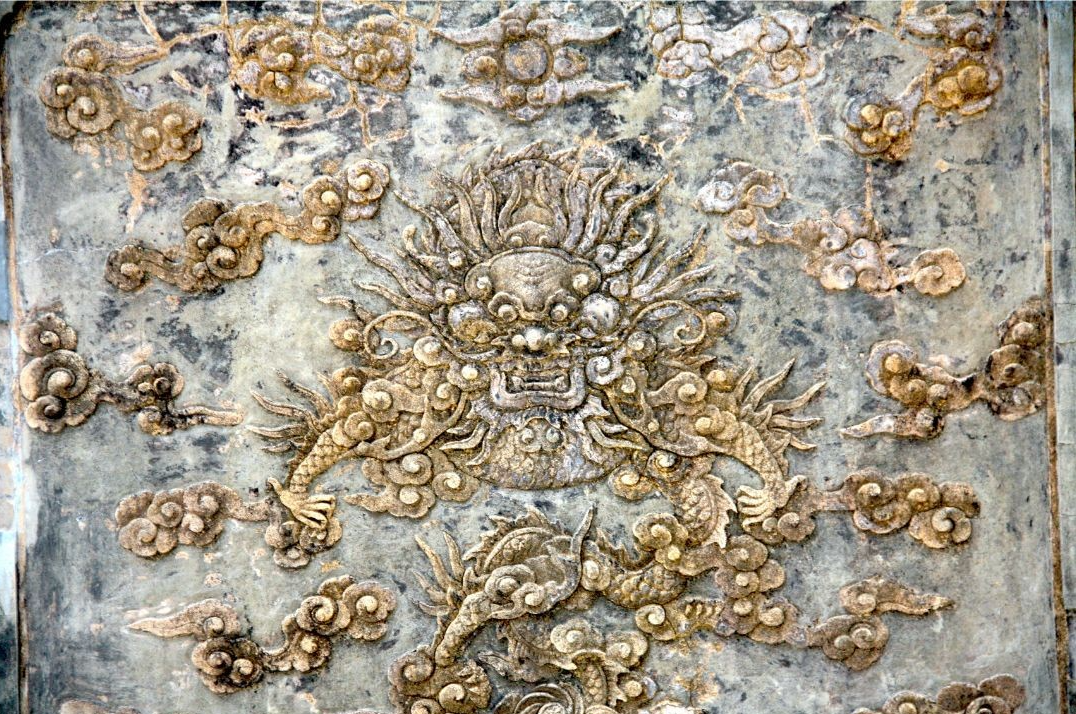 |
| Here be dragons. Photo by Glen MacDonald. |
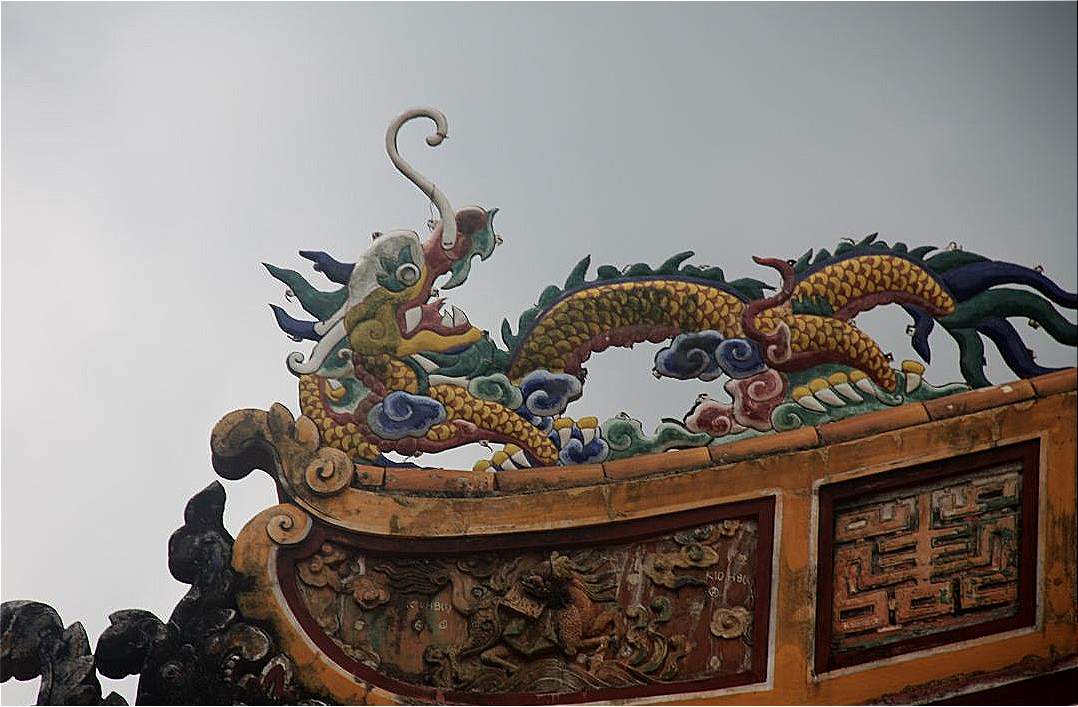 |
| Experience the colors of a grand tomb. Photo by Glen MacDonald. |
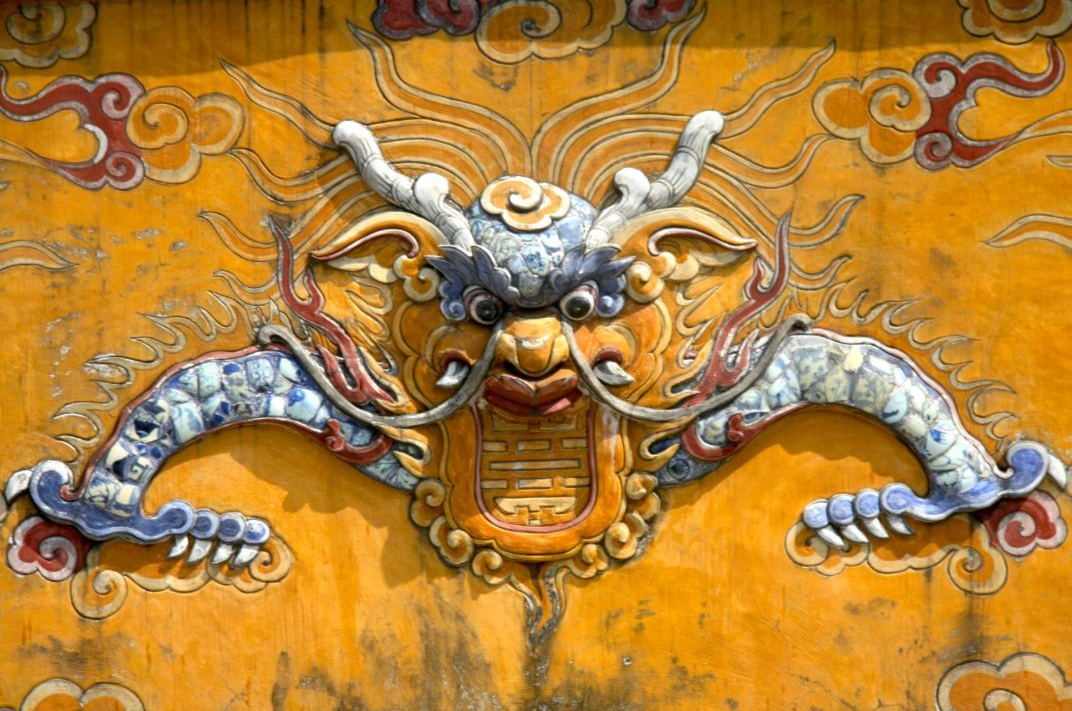 |
| A firece graveside guardian. Photo by Glen MacDonald. |
The Tomb of Dong Khanh is a complex mixture of the East and West. The grounds are inspired by Chinese stories, ancient Roman architecture, zodiac symbology, and images of the Napoleonic wars. Despite being a grim area, the playful colors of the tomb offer a rather charming, lively vibe.
While Dong Khanh was laid to rest in his Eurasian-styled tomb, the king's visage lives on in French photography. Prior to the young Francophile's ascent to the throne, it was against the customs of the Nguyen Lords to be photographed by outsiders. However, that elusive streak was broken by Dong Khanh, who agreed to pose for French photographers in his royal court. While he broke from tradition, Dong Khanh allowed for royal splendor to be forever captured in photos, giving the modern world an intimate glimpse into Vietnam's imperial past.
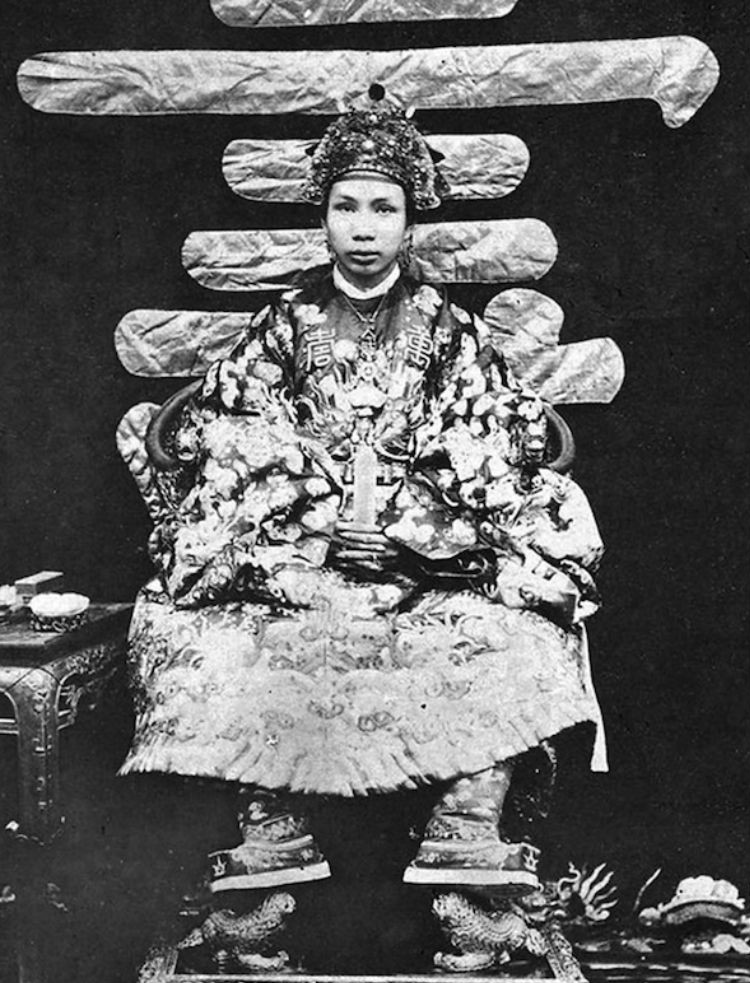 |
| Dong Khanh on the throne, photographed by French colonizers. |
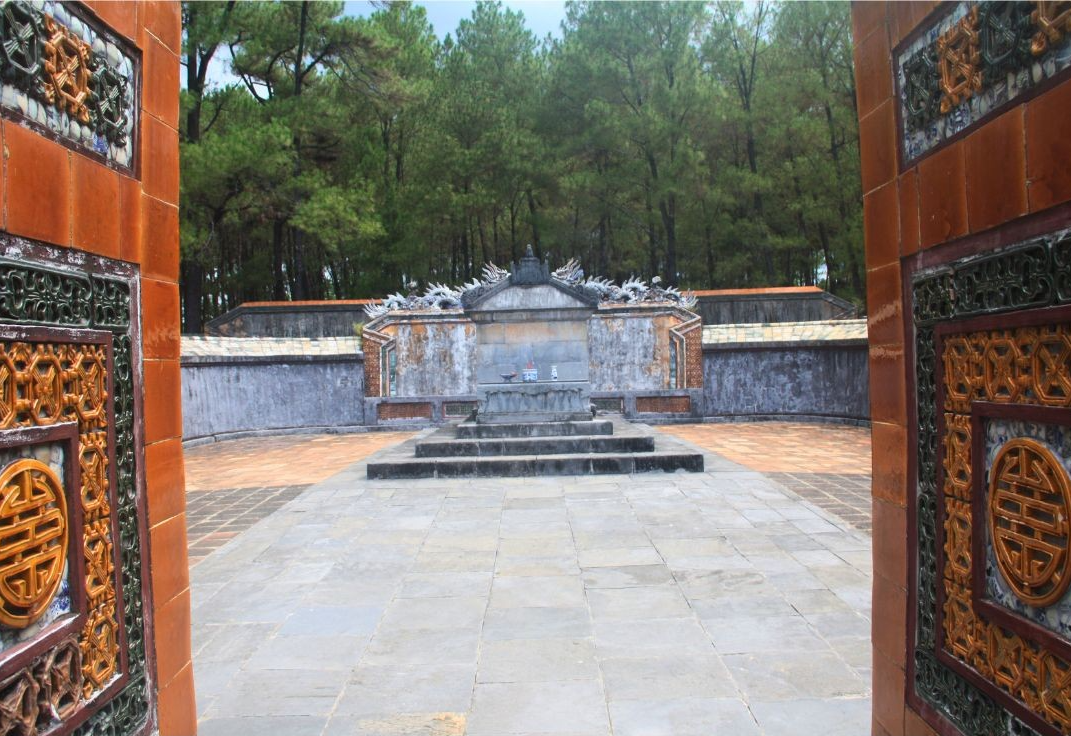 |
| The final resting place of Dong Khanh. Photo by Glen MacDonald. |
Mausoleum of Emperor Khai Dinh - Resting in Eternal Elegance
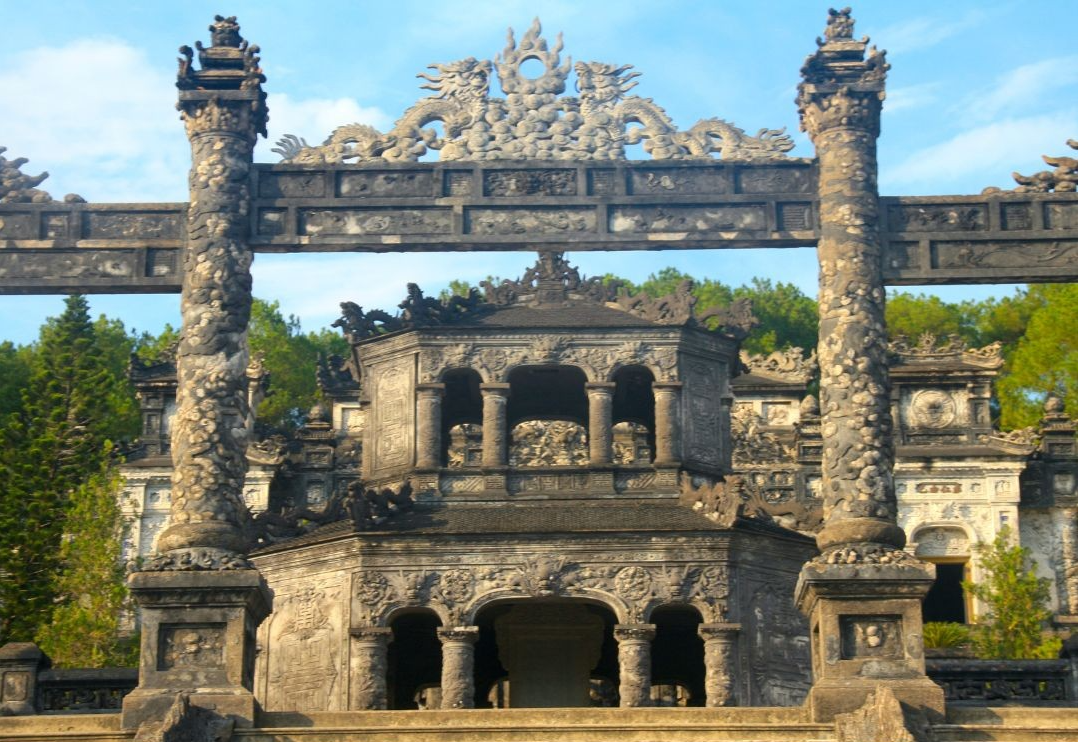 |
| Emperor Khai Dinh's Masoleum. Photo by Glen MacDonald. |
The reign of Emperor Khai Dinh came after years of exiled kings and French-appointed rulers. By his time, the Vietnamese people became disillusioned with the Nguyen Kings, who mostly viewed them as puppets for colonial masters.
Khai Dinh raised taxes to fund his life of luxury. Instead of holding court, Khai Dinh preferred to romance his loyal bodyguard. Additionally, to appease the French, Khai Dinh ordered romanticizing the Vietnamese alphabet, forgoing generations of Vietnam's written tradition.
A young Ho Chi Minh, sickened by the ineffectiveness of the Nguyen Lords, encapsulated his feelings of Khai Dinh in his play entitled, "The Bamboo Dragon." Within the play, an antique collector fashions a toy dragon out of bamboo. While the toy believes itself to be a mighty dragon, in actuality, it remains as a simple handicraft made out of quite common material found in Vietnam. Ho Chi Minh's biting satire was not lost on the mistreated Vietnamese proletariat.
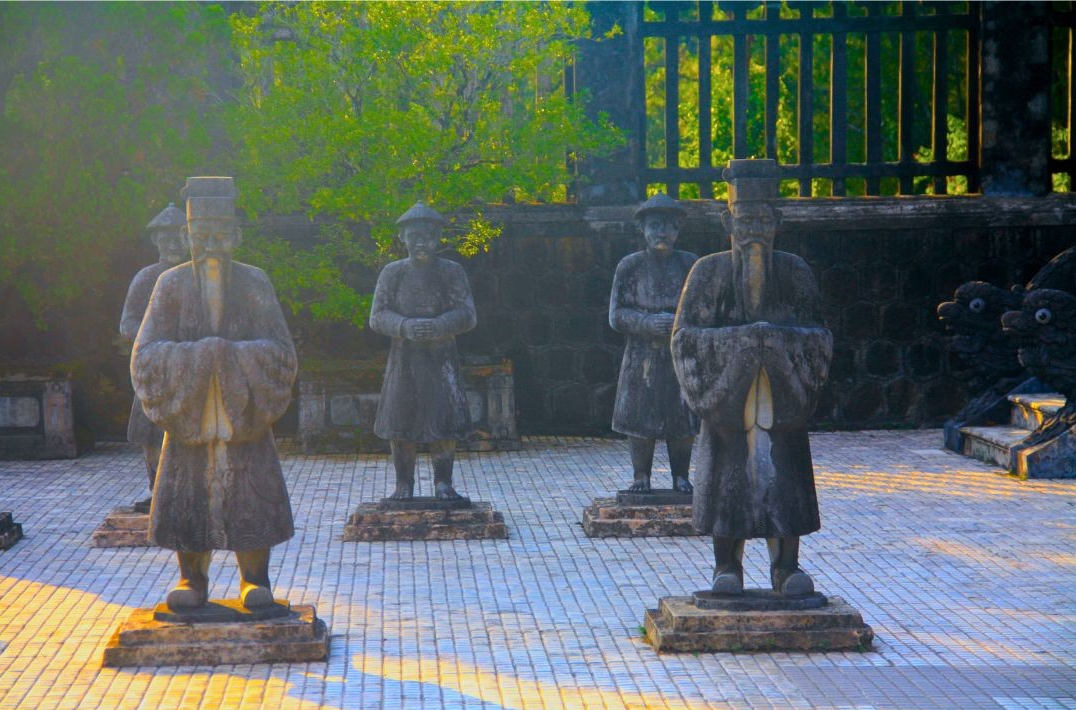 |
| Statues of Khai Dinh's court. Photo by Glen MacDonald. |
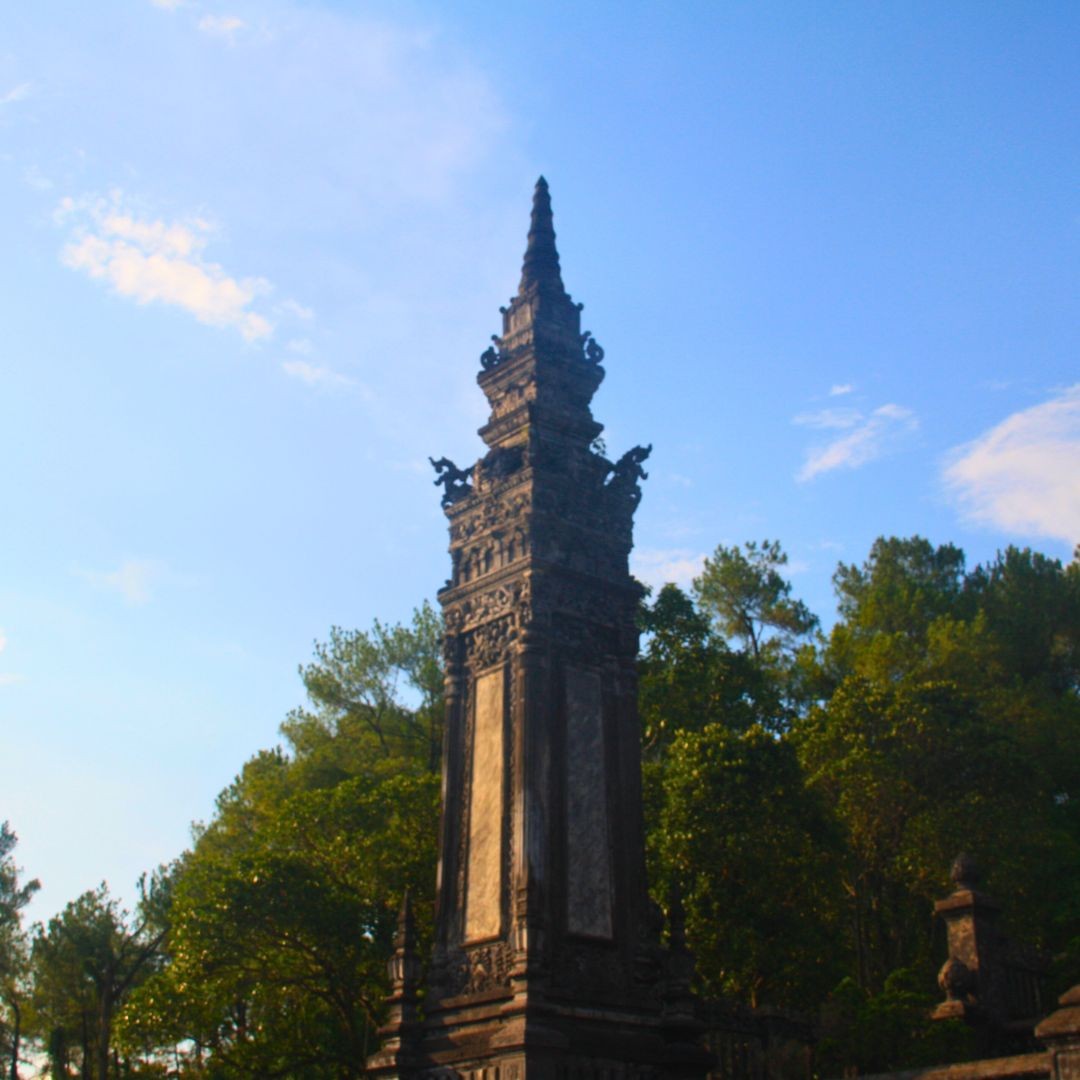 |
| An impressive steeple. Photo by Glen MacDonald. |
In death, Khai Dinh remained just as flagrant as he was in life. A majority of the taxes he raised went to his tomb and it certainly shows. Along every corner rests black, stone dragons with mesmerizing eyes. Statues of his royal court remain on guard outside of the tomb. Following in the tradition of Dong Khanh, the tomb mixes Gothic European architecture with ancient Vietnamese design.
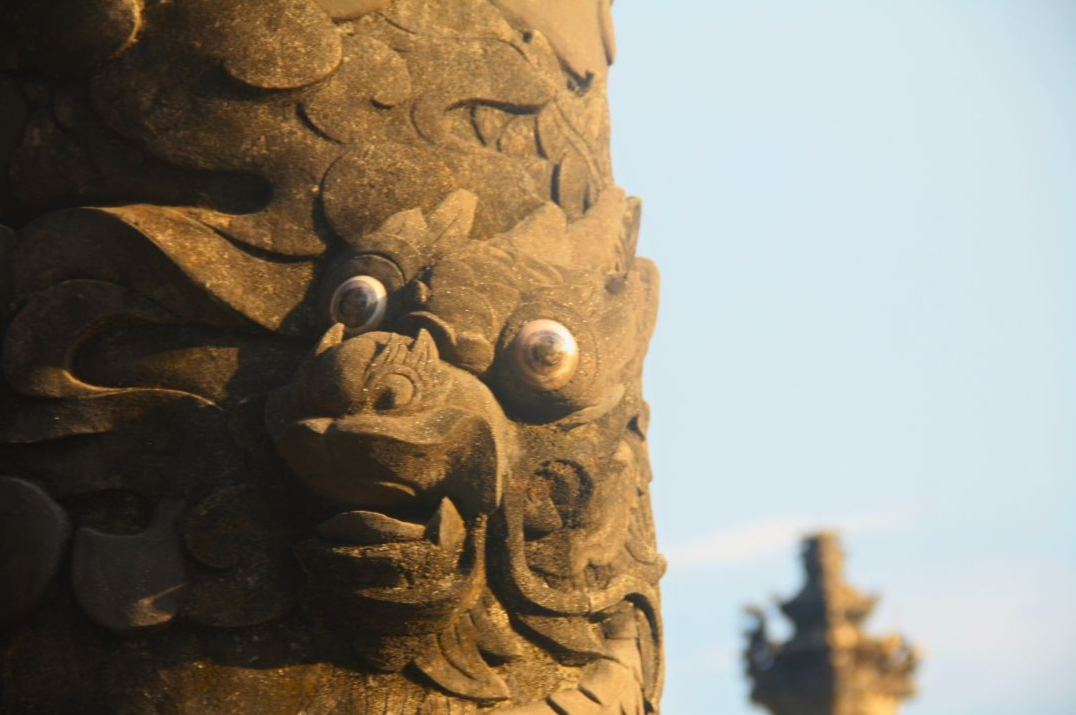 |
| A stone dragon during sunset. Photo by Glen MacDonald. |
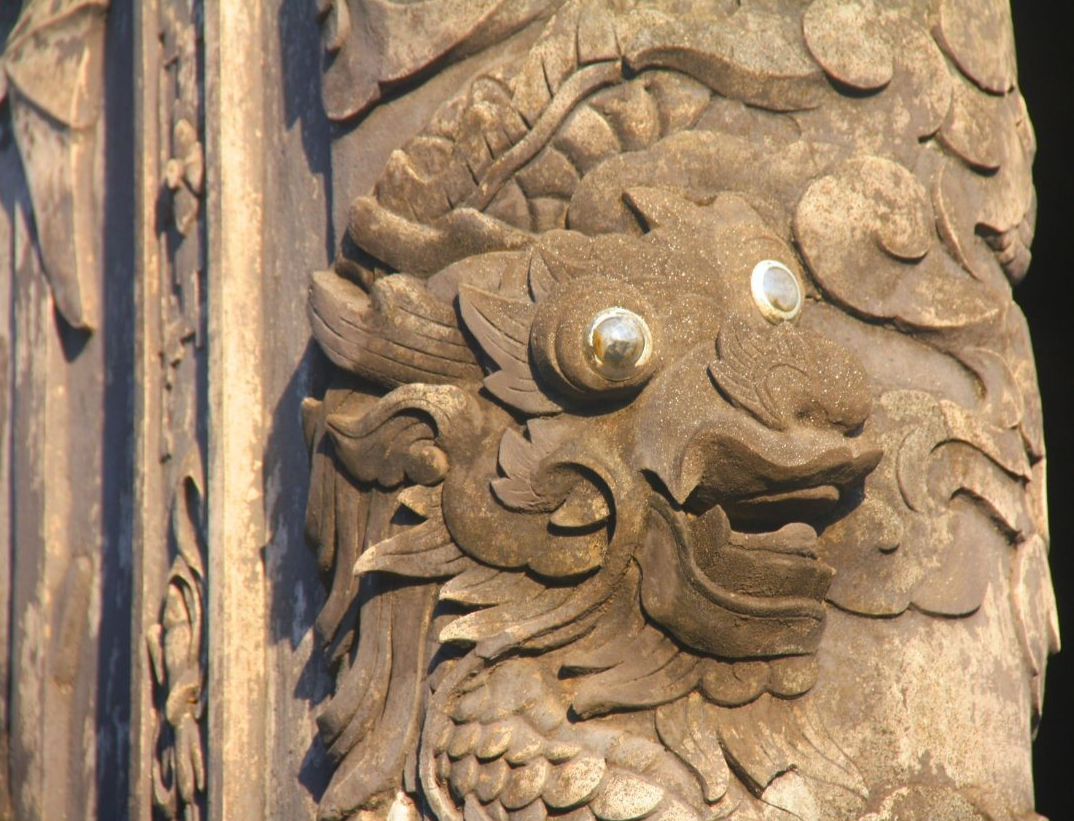 |
| Looking westward. Photo by Glen MacDonald. |
The inside of the tomb resembles a European villa with immaculate frescos, a stunning chandelier, and compartments decorated with porcelain and colorful glassware. In the center of the room is a bronze statue of Khai Dinh, eternally facing the western horizon and the setting sun.
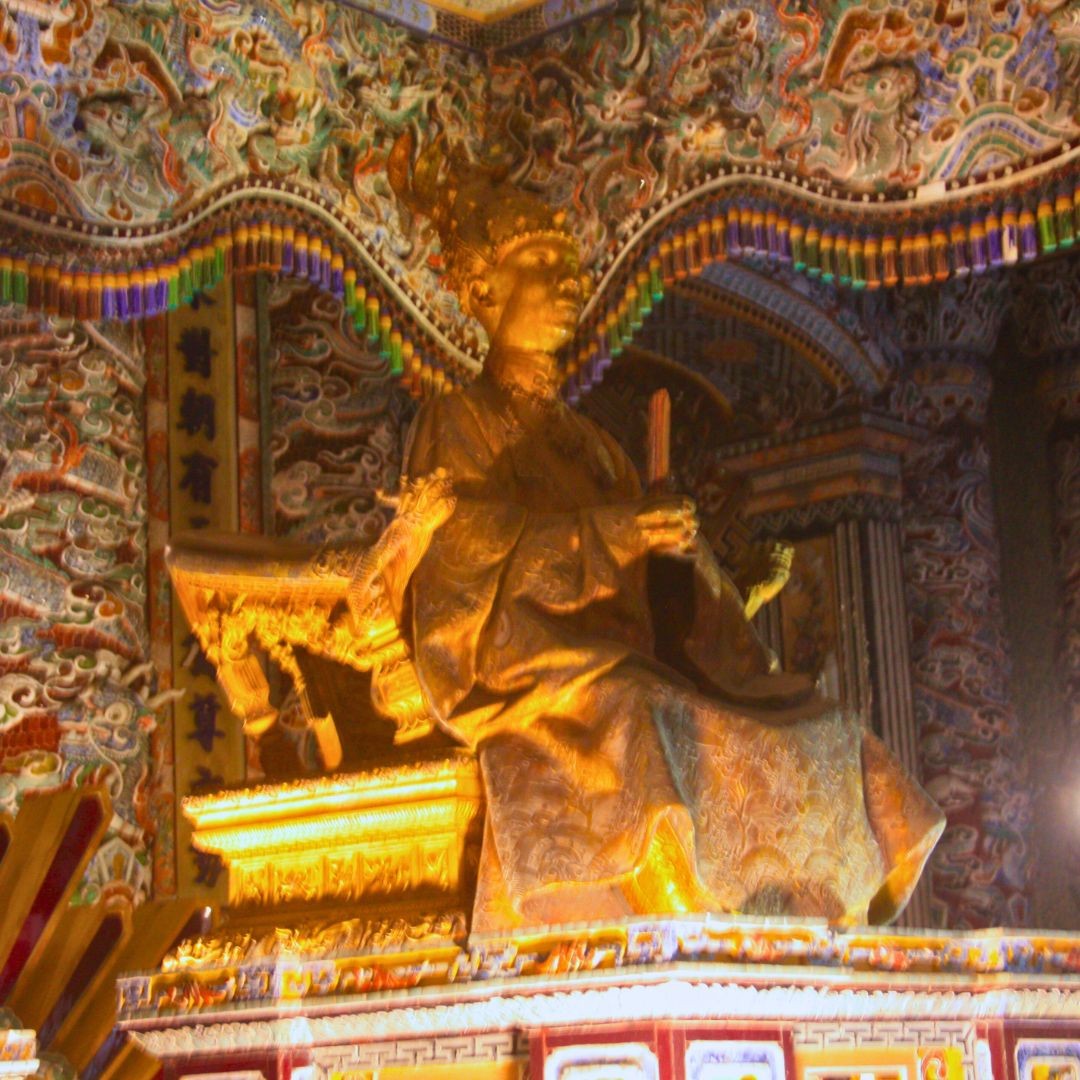 |
| Khai Dinh, forever on his throne. Photo by Glen MacDonald. |
Hue's Abandoned Water Park - A Haunting Grounds for Commoners
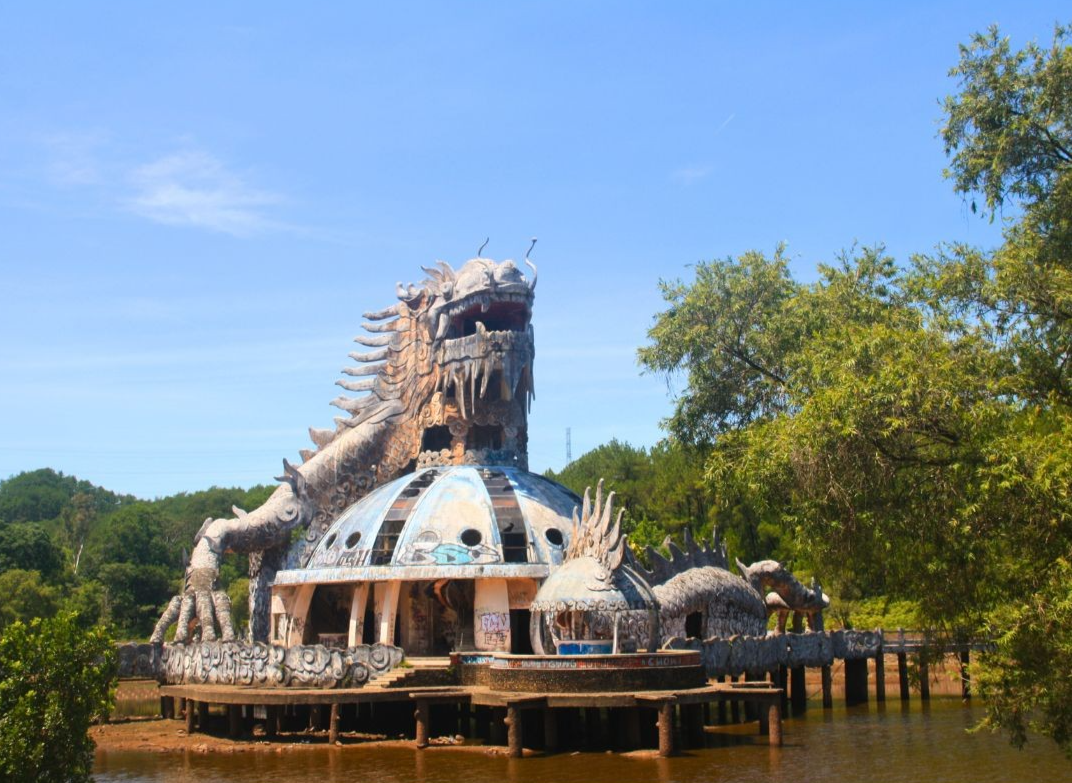 |
| Hue's sleeping dragon. Photo by Glen MacDonald. |
The final stop for Hue's "tomb-hopping" tour is the world-famous abandoned water park. According to local legends, the park is haunted by scores of unnamed ghosts. The park first opened in 2004 and was quickly closed two years after for ineffective operation. Various superstitions and ghost stories have kept investors from refurbishing the park.
Whether it is fact or fiction, the stories are ominous enough to keep people from visiting it at night. Yet, during the day, the abandoned site makes for an eerie adventure for urban explorers. A building in the shape of a magnificent dragon stares over an inky, black lake. If you are brave enough to traipse over the broken glass and through the pitch-black interior, you can make your way to the dragon's mouth and be treated to an idyllic view of Hue's deep forests.
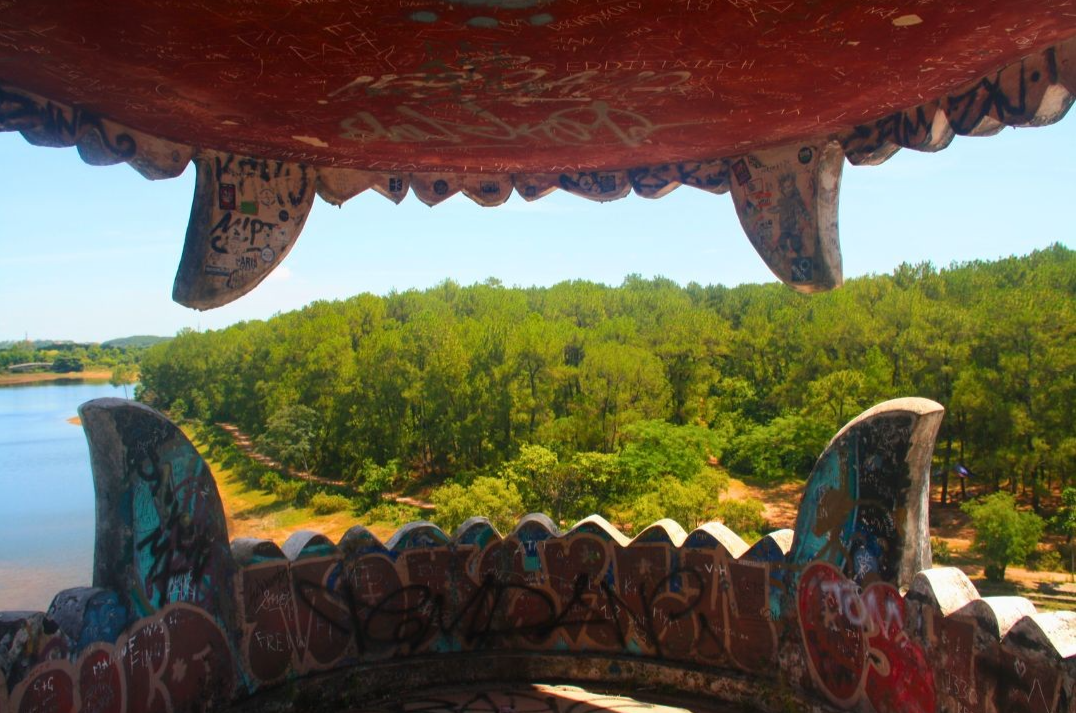 |
| The view from the belly of the beast. Photo by Glen MacDonald. |
Leaning next to the monster's teeth, it is easy to imagine how the abandoned waterpark makes a spirited home for Hue's commoners. Generations of ghosts could gather at the sleeping dragon for midnight parties, reminiscing about their past lives and pondering the next.
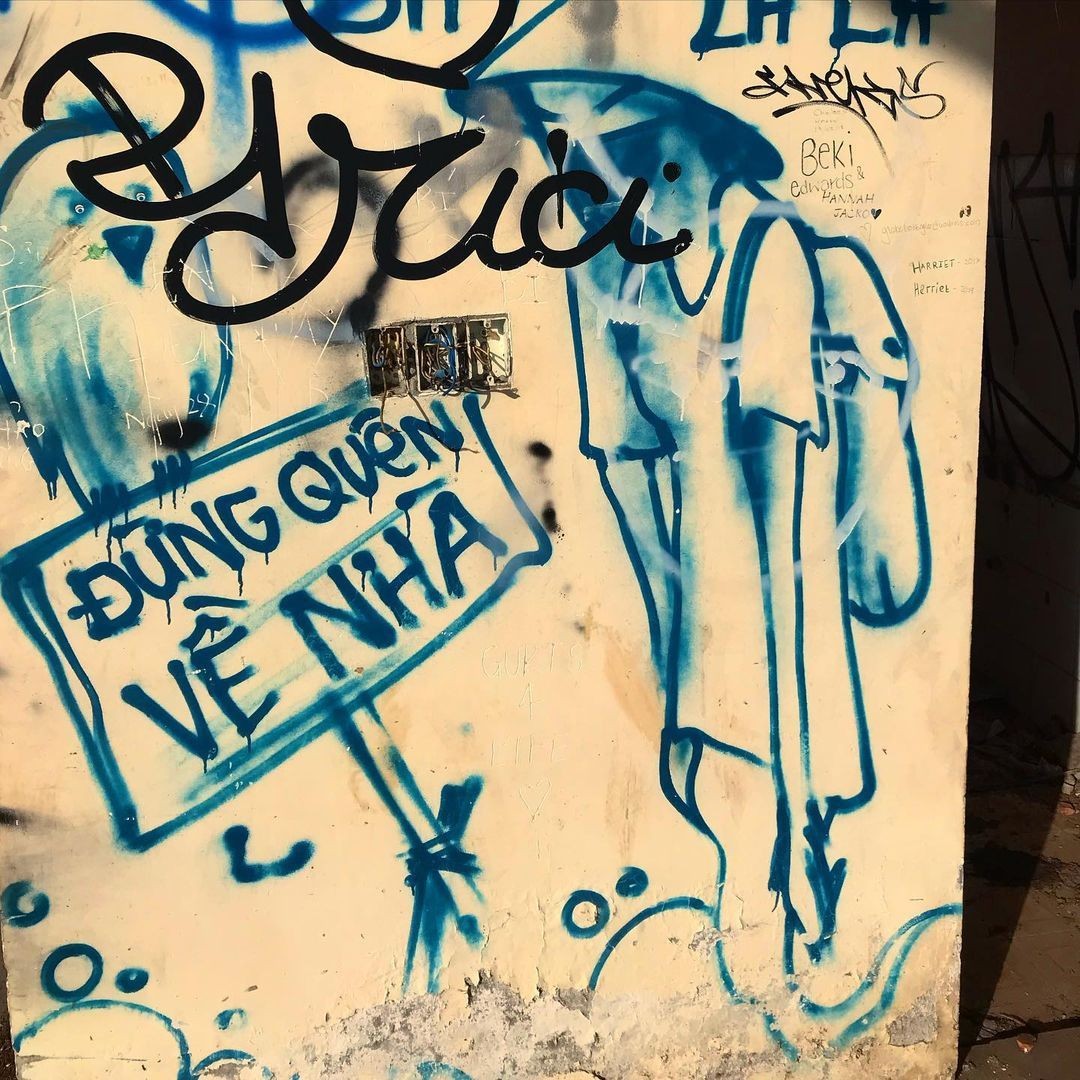 |
| Ghostly graffiti. Photo by Glen MacDonald. |
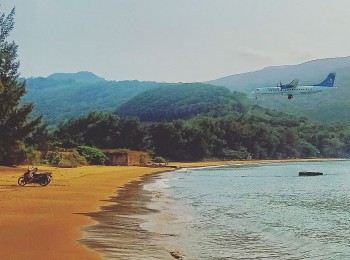 | Travel Around: Mysterious Knife These tiny Vietnamese islands are a crucial waypoint in time; Their harsh, colonial past overlaps with a hopeful, green future. |
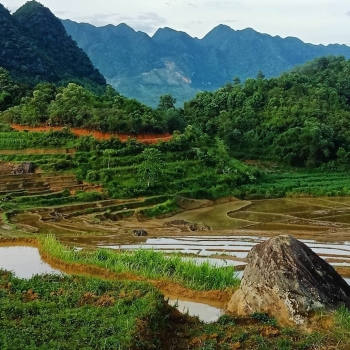 | Travel Around: Pu Luong at Midsummer Last month, staff writer Glen MacDonald found himself celebrating a Finnish holiday in the jungles of northern Vietnam; a surprisingly beautiful combination. |
 | Travel Around: Mai Chau - The Ideal Weekend Retreat from the City Mai Chau, in the mountainous, nature-filled Hoa Binh province is perfect for a short escape from the hustle and bustle of the city. Travel writers... |
Recommended
 Travel
Travel
Vietnam Through Australian Eyes: Land of Flavor, Warmth, and Timeless Charm
 Travel
Travel
Strategies for Sustainable Growth of Vietnam’s Tourism from International Markets
 Travel
Travel
Vietnam Strengthens Its Presence On The Global Tourism Map
 Multimedia
Multimedia
Phong Nha-Ke Bang National Park Named Top Adventure Travel Site
 Travel
Travel
Vietnam Welcomes Record-High Number of International Visitors
 Travel
Travel
Luxury Train From Hanoi To Hai Phong To Be Launched In May
 Travel
Travel
Phong Nha Named Top Budget-Friendly Travel Destination for Spring 2025: Agoda
 Travel
Travel
